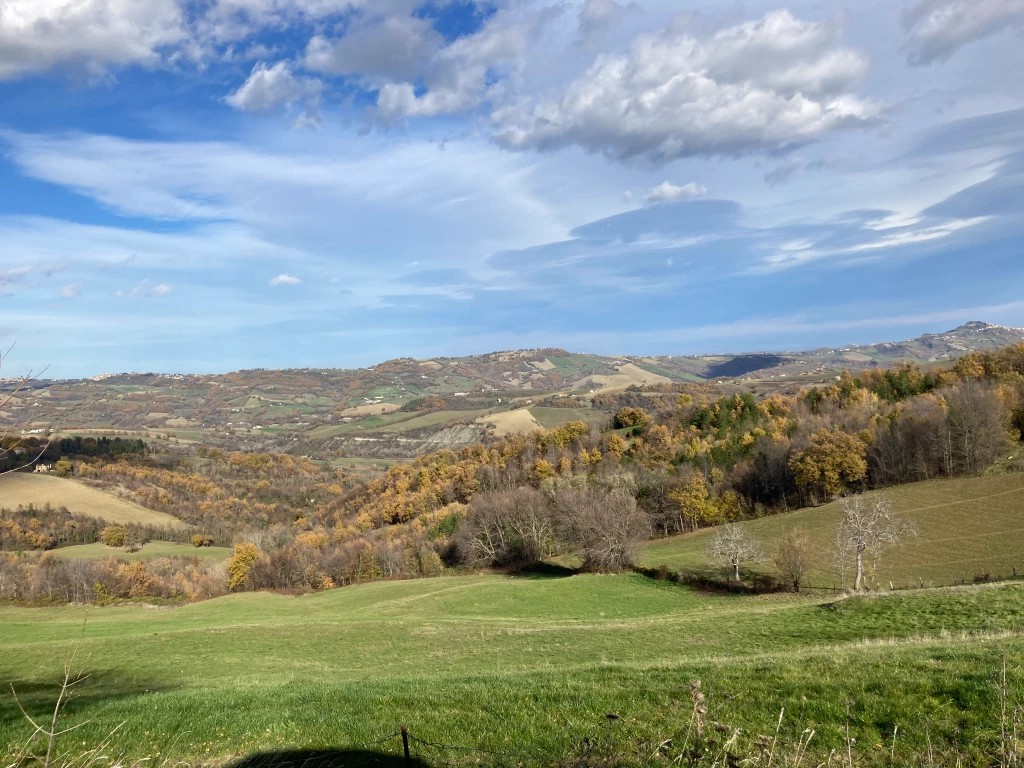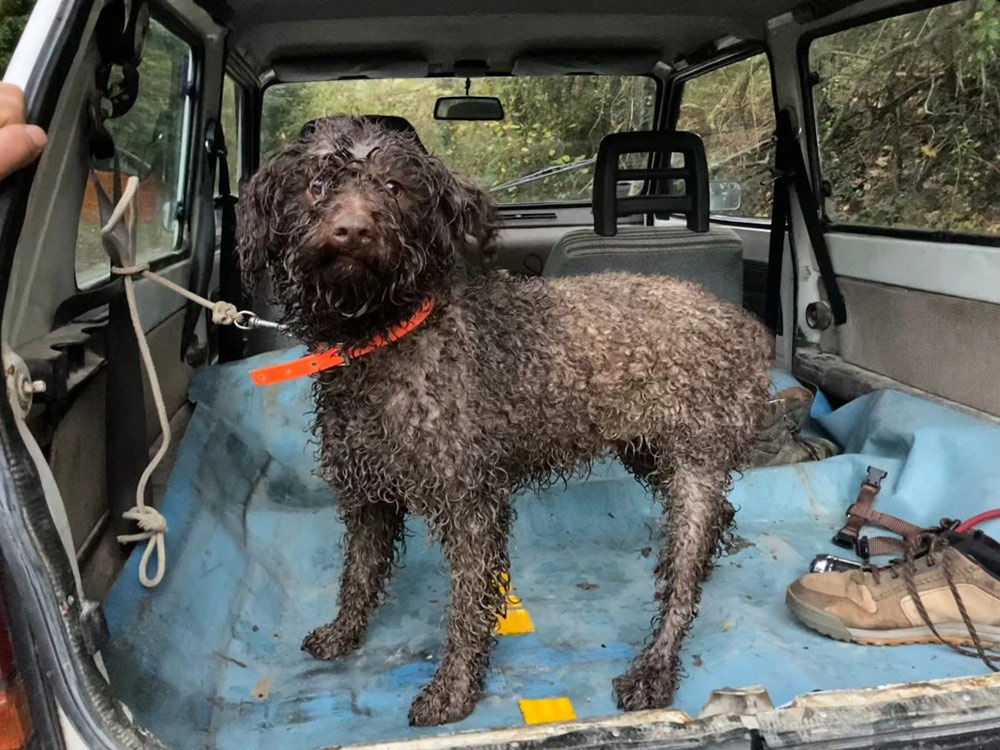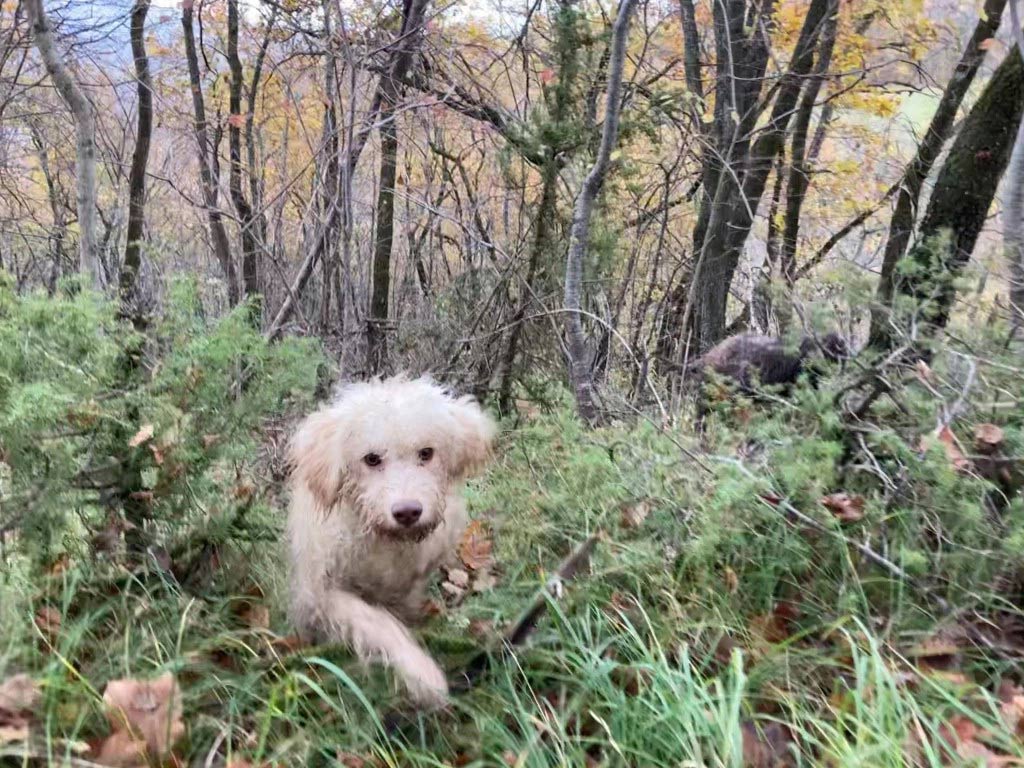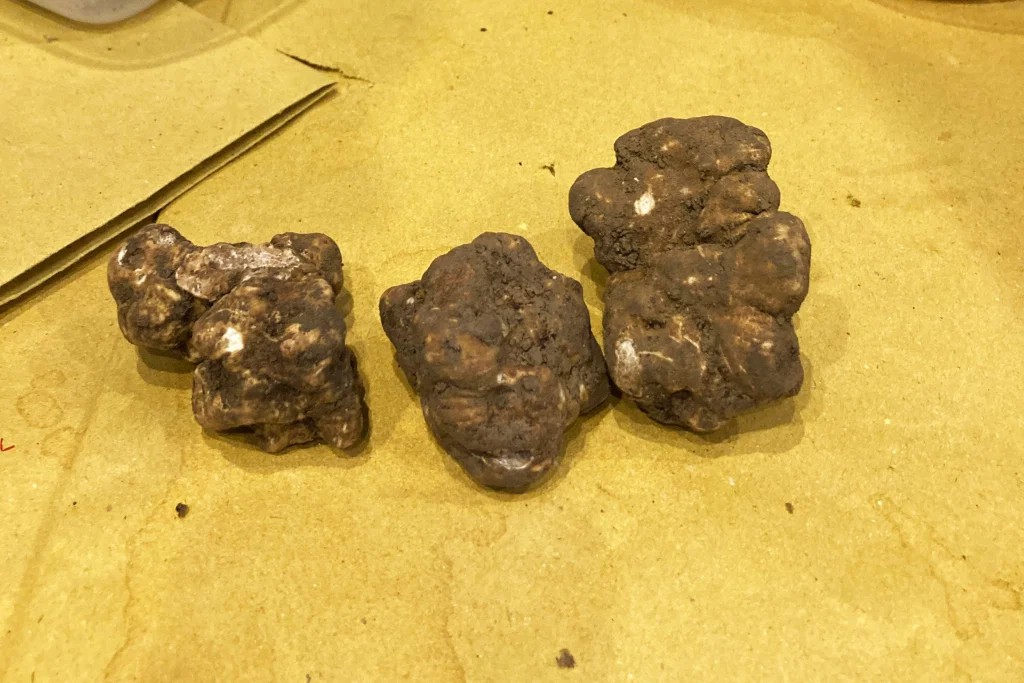珍贵的意大利白松露继续打破纪录。
松露因太过稀少所以外号叫做白金,长期以来一直是奢华美食象征,基本上以克为单位计算,跟伊朗白鲸鱼子酱和番红花同为全世界最昂贵的食物之一。
今年也不例外。虽然餐饮业濒临崩溃,全球各地发布旅游禁令,而且遭逢全球经济衰退,但并未影响有钱美食家斥巨资争抢昂贵的白松露。
上个月在意大利阿尔巴松露镇一年一度的白松露拍卖会上,世界各地的竞拍者蜂拥而至竞购0.9公斤重的大松露。放心,潜在买家根本闻不到白松露的香味,也没法盯着找瑕疵。(跟2020年其他活动一样,拍卖会是在线举办的。)
即便没法一睹真容,本次展出的松露售价仍高达10万欧元(约合12.1万美元)。
“菌菇届莫扎特”
从供求规律就能解释售价为何如此之高。体积能达到这般水平的白松露在地球上只有极个别地方能找到,往往藏在地表之下,从橡树、山毛榉和杨树根部吸收养分。一旦挖出就会迅速失去水分,迷人的泥土芬芳也逐渐消散。据说,刚出土的松露具有催情效用,更是平添了神秘感,古人称其为“神之珍馐”。文艺复兴时期白松露曾是欧洲宫廷内专享的奢侈品。18世纪意大利作曲家乔阿奇诺•罗西尼称之为“菌菇届莫扎特”。
意大利西北部的阿尔巴是最著名的白松露产地,意大利中部的亚平宁山脉也偶有发现,分布在托斯卡纳、翁布里亚和罗西尼的故乡勒马尔凯等。大部分产地都面临威胁。全球需求飙升之际,气候变化和白松露林地栖息地迅速消失,都对供应形成了挤压。
这样一来,不断攀升的松露价格不再仅仅是衡量享乐主义地位的标准。在大规模城市化、工厂化耕作和绿地减少的时代,松露价格通胀情况也是林地生态系统健康状况受到威胁的指标。

到树林里去
“今年很艰难,”来自意大利阿曼多拉的tartufaio(松露猎人)伦索•巴尔东奇尼告诉我。多年来,巴尔东奇尼一直是我最可靠的松露供应商。今年他同意带我到树林里亲自体验寻找的过程。同行的还有两条狗——露娜和西拉,狗的鼻子经过训练,可以帮忙(希望如此)寻找气味芬芳的松露。
露娜和西拉同属于意大利猎犬品种,即拉格托-罗曼诺洛犬,之前帮过很多松露猎人。几年前,露娜找到过一块番茄大小的白松露,后来巴尔东奇尼以350欧元的价格卖给了松露经纪人。
西拉则是啃拖鞋高手。她才七个月大,在松露猎手圈是纯新手。西拉也是我们华纳家的新成员,疫情期间刚来。(居家隔离时女儿们极力劝说想养条狗。我提出一个条件,只接受拉格托。我的理由是,养狗就要养时不时能找来食物的那种。)

露娜(上图)相当专业。松露犬所有的理想特征露娜都有:专注,无所畏惧而且意志坚定。露娜嗅觉非常灵敏,动作也迅速,几码外就能追踪到松露的气味。
我们一进树林,巴尔东奇尼就给露娜下各种指令:vai(前进!),su(爬上去!),giù(下来!)。露娜在各种崎岖险峻的地形穿梭。西拉也很棒,一直在后面跟着露娜。两条狗狗在泥泞中滑行,在倒伏的树枝下爬动,跳过树干,在厚厚的荆棘墙上查看小洞,还在溪流中溯游。西拉经常回来看我。“你能行吗,老人家?”她的表情似乎在说。
露娜偶尔看上去像找到什么线索。她把鼻子贴在地上,用爪子把泥土刨开闻一闻,用爪子戳一下。然后找下一个。
期待让人激动,也或许因为一路都是上山路,我的心怦怦直跳。我不止一次在白日梦里找到个大家伙,回家后做道意大利肉汁烩饭或宽面。
西拉经验还是有点欠缺。毕竟之前只训练过一次,就是把棉花球浸过白松露油然后埋在院子里。如果西拉循着气味找到,就给点好吃的当奖赏。训练时她表现不错,我觉得挺有寻找松露的天赋。
然而一动起真格,用意大利人的话说,西拉“简直糟透了”。从抵达可能发现松露的地方开始,西拉更想跟露娜玩,兴趣可比狩猎大多了。只要有机会,西拉都会开玩笑地用前爪拍拍露娜,期望露娜回应。露娜一点也没兴趣。露娜停下研究周围树木寻找线索时,西拉总在分散注意力。

露娜的鼻子趴在地上,对准有望收获的地点,西拉欣喜若狂,绕着旁边的露娜转来转去,转的圈子越来越小。“西拉,calma,calma,”我用意大利语呼唤着。意思是冷静下来。西拉对我吼了一声,然后激动地冲着露娜叫。
我的心一沉。比赛一开始,西拉就像个没法专心的棒球小子,运球手打给投手后都能弄反方向跑去三垒。不管怎样,我就是这种感觉。露娜放弃了。西拉还是在拍她。
我向巴尔东奇尼道歉。他咧嘴一笑,向我挥了挥手。“没事的,”他安慰说。
我们两手空空走出树林。两条狗浑身是泥,朝着巴尔东奇尼的菲亚特熊猫汽车方向小跑。
这些年来,阿曼多拉周围的树林里出土过各种各样的大块松露。很多松露卖给了全国各地的餐馆。品相最优质的则远销国外,出现在香港、伦敦或拉斯维加斯的米其林餐厅菜单上。我们可吃不起那么顶级的松露。
第二天早上,我去阿曼多拉村想买块白松露带回罗马。我听了巴尔东奇尼的建议,在离主广场不远的路上找到一家商店。店主说我很幸运,然后从冰箱里拿出个塑料容器,凹凸的松露块摆了一排。“今天早上刚挖的,”他自豪地说。房间里充满了松露的香味,戴着口罩都清晰可闻。
“你在哪找到的?”虽然知道他肯定不会透露地点,我还是问了一句。“就在附近,”他犹豫了一下说。
我花60欧元现金买了几块,加起来有45克,做一顿像样的午餐肯定没问题了。

第二天,妻子做了一份简单的意大利肉汁饭。我把松露块刮在盘子上,让感官充分享受新鲜食材的美妙香味。
妻子算了一笔账,如果在高级餐厅这样一顿午餐可得花不少钱。我拍胸脯保证,明年一定要跟西拉带着自己挖到的松露凯旋而归。(财富中文网)
译者:夏林
珍贵的意大利白松露继续打破纪录。
松露因太过稀少所以外号叫做白金,长期以来一直是奢华美食象征,基本上以克为单位计算,跟伊朗白鲸鱼子酱和番红花同为全世界最昂贵的食物之一。
今年也不例外。虽然餐饮业濒临崩溃,全球各地发布旅游禁令,而且遭逢全球经济衰退,但并未影响有钱美食家斥巨资争抢昂贵的白松露。
上个月在意大利阿尔巴松露镇一年一度的白松露拍卖会上,世界各地的竞拍者蜂拥而至竞购0.9公斤重的大松露。放心,潜在买家根本闻不到白松露的香味,也没法盯着找瑕疵。(跟2020年其他活动一样,拍卖会是在线举办的。)
即便没法一睹真容,本次展出的松露售价仍高达10万欧元(约合12.1万美元)。
“菌菇届莫扎特”
从供求规律就能解释售价为何如此之高。体积能达到这般水平的白松露在地球上只有极个别地方能找到,往往藏在地表之下,从橡树、山毛榉和杨树根部吸收养分。一旦挖出就会迅速失去水分,迷人的泥土芬芳也逐渐消散。据说,刚出土的松露具有催情效用,更是平添了神秘感,古人称其为“神之珍馐”。文艺复兴时期白松露曾是欧洲宫廷内专享的奢侈品。18世纪意大利作曲家乔阿奇诺•罗西尼称之为“菌菇届莫扎特”。
意大利西北部的阿尔巴是最著名的白松露产地,意大利中部的亚平宁山脉也偶有发现,分布在托斯卡纳、翁布里亚和罗西尼的故乡勒马尔凯等。大部分产地都面临威胁。全球需求飙升之际,气候变化和白松露林地栖息地迅速消失,都对供应形成了挤压。
这样一来,不断攀升的松露价格不再仅仅是衡量享乐主义地位的标准。在大规模城市化、工厂化耕作和绿地减少的时代,松露价格通胀情况也是林地生态系统健康状况受到威胁的指标。
到树林里去
“今年很艰难,”来自意大利阿曼多拉的tartufaio(松露猎人)伦索•巴尔东奇尼告诉我。多年来,巴尔东奇尼一直是我最可靠的松露供应商。今年他同意带我到树林里亲自体验寻找的过程。同行的还有两条狗——露娜和西拉,狗的鼻子经过训练,可以帮忙(希望如此)寻找气味芬芳的松露。
露娜和西拉同属于意大利猎犬品种,即拉格托-罗曼诺洛犬,之前帮过很多松露猎人。几年前,露娜找到过一块番茄大小的白松露,后来巴尔东奇尼以350欧元的价格卖给了松露经纪人。
西拉则是啃拖鞋高手。她才七个月大,在松露猎手圈是纯新手。西拉也是我们华纳家的新成员,疫情期间刚来。(居家隔离时女儿们极力劝说想养条狗。我提出一个条件,只接受拉格托。我的理由是,养狗就要养时不时能找来食物的那种。)
露娜(上图)相当专业。松露犬所有的理想特征露娜都有:专注,无所畏惧而且意志坚定。露娜嗅觉非常灵敏,动作也迅速,几码外就能追踪到松露的气味。
我们一进树林,巴尔东奇尼就给露娜下各种指令:vai(前进!),su(爬上去!),giù(下来!)。露娜在各种崎岖险峻的地形穿梭。西拉也很棒,一直在后面跟着露娜。两条狗狗在泥泞中滑行,在倒伏的树枝下爬动,跳过树干,在厚厚的荆棘墙上查看小洞,还在溪流中溯游。西拉经常回来看我。“你能行吗,老人家?”她的表情似乎在说。
露娜偶尔看上去像找到什么线索。她把鼻子贴在地上,用爪子把泥土刨开闻一闻,用爪子戳一下。然后找下一个。
期待让人激动,也或许因为一路都是上山路,我的心怦怦直跳。我不止一次在白日梦里找到个大家伙,回家后做道意大利肉汁烩饭或宽面。
西拉经验还是有点欠缺。毕竟之前只训练过一次,就是把棉花球浸过白松露油然后埋在院子里。如果西拉循着气味找到,就给点好吃的当奖赏。训练时她表现不错,我觉得挺有寻找松露的天赋。
然而一动起真格,用意大利人的话说,西拉“简直糟透了”。从抵达可能发现松露的地方开始,西拉更想跟露娜玩,兴趣可比狩猎大多了。只要有机会,西拉都会开玩笑地用前爪拍拍露娜,期望露娜回应。露娜一点也没兴趣。露娜停下研究周围树木寻找线索时,西拉总在分散注意力。
露娜的鼻子趴在地上,对准有望收获的地点,西拉欣喜若狂,绕着旁边的露娜转来转去,转的圈子越来越小。“西拉,calma,calma,”我用意大利语呼唤着。意思是冷静下来。西拉对我吼了一声,然后激动地冲着露娜叫。
我的心一沉。比赛一开始,西拉就像个没法专心的棒球小子,运球手打给投手后都能弄反方向跑去三垒。不管怎样,我就是这种感觉。露娜放弃了。西拉还是在拍她。
我向巴尔东奇尼道歉。他咧嘴一笑,向我挥了挥手。“没事的,”他安慰说。
我们两手空空走出树林。两条狗浑身是泥,朝着巴尔东奇尼的菲亚特熊猫汽车方向小跑。
这些年来,阿曼多拉周围的树林里出土过各种各样的大块松露。很多松露卖给了全国各地的餐馆。品相最优质的则远销国外,出现在香港、伦敦或拉斯维加斯的米其林餐厅菜单上。我们可吃不起那么顶级的松露。
第二天早上,我去阿曼多拉村想买块白松露带回罗马。我听了巴尔东奇尼的建议,在离主广场不远的路上找到一家商店。店主说我很幸运,然后从冰箱里拿出个塑料容器,凹凸的松露块摆了一排。“今天早上刚挖的,”他自豪地说。房间里充满了松露的香味,戴着口罩都清晰可闻。
“你在哪找到的?”虽然知道他肯定不会透露地点,我还是问了一句。“就在附近,”他犹豫了一下说。
我花60欧元现金买了几块,加起来有45克,做一顿像样的午餐肯定没问题了。
第二天,妻子做了一份简单的意大利肉汁饭。我把松露块刮在盘子上,让感官充分享受新鲜食材的美妙香味。
妻子算了一笔账,如果在高级餐厅这样一顿午餐可得花不少钱。我拍胸脯保证,明年一定要跟西拉带着自己挖到的松露凯旋而归。(财富中文网)
译者:夏林
The prized Italian white truffle continues to shatter records.
This precious fungus—nicknamed, white gold—has long been a symbol of gastronomic decadence, ranking, gram for gram, as one of the most expensive foods in the world—up there with Iranian beluga caviar and saffron.
This year is no different. A collapse in restaurant dining, worldwide travel bans, and a global recession haven’t stopped well-heeled gastronomes from splashing out huge sums on the prized tuber magnatum pico.
Last month, at an annual white truffle auction—held in truffle town: Alba, Italy—a bevy of bids flooded in from around the world for a handsome 2-pound specimen. Never mind that the hopefuls couldn’t smell the goods, or eyeball it for imperfections. (Like everything else in 2020, it was a virtual affair).
Still, the truffle on display went for €100,000 ($121,000).
"The Mozart of funghi"
The law of supply and demand explains such out-of-whack prices. The mighty white truffle can only be found in select places on Earth—well underground, drawing nutrients from the roots of oak, beech and poplar trees. Once dug up, it rapidly loses moisture and that mesmerizing earthy essence. It’s been said freshly unearthed truffles have the qualities of an aphrodisiac, adding to the myth and mystique that this is, as the ancients crowned it, the “food of the gods.” It was a luxury in the finest courts of Renaissance Europe. The 18th century Italian composer Gioachino Rossini called it the “Mozart of funghi.”
Alba in Northwest Italy is the most famous of the white truffle’s haunts, but there are also hot spots in the Apennines of Central Italy that span Tuscany, Umbria and Rossini’s homeland, Le Marche. Most of these patches are under threat. Climate change and the rapid loss of the white truffle’s woodlands habitat are combining to bulldoze supply just as global demand soars.
In this way, escalating truffle prices aren’t just a benchmark for epicurean status. The inflation is also an indicator for the health of a threatened woodland ecosystem in an age of mass urbanization and factory farming and dwindling green spaces.
Into the woods we go
“It’s been a difficult year,” Renzo Baldoncini, a tartufaio (truffle hunter) hailing from Amandola, Italy, told me. Over the years, Baldoncini has been my most reliable truffle supplier. This year he agreed to take me into the woods to forage for these precious tubers. Joining us were Luna and Scilla, two dogs with a special, highly attuned nose to unearth (hopefully) these aromatic wonders.
Luna and Scilla come from a long line of truffle hunters. They are of the Italian hunting dog breed, the Lagotto Romagnolo. A few years ago, Luna unearthed a tomato-sized white truffle that Baldoncini later sold to a truffle broker for €350.
Scilla, meanwhile, is a champion slipper-eater. At seven months old, she's still a truffle hunt rookie. She’s also the newest member of the Warner family, our pandemic puppy. (It was our girls who lobbied hard for a dog once lockdown hit. I had one condition: I’ll only consider a Lagotto. My rationale: I want a pup that could put food on our table every now and then.)
Luna (pictured above) is a pro. She has all the traits you want in a truffle dog. She is focused, fearless and determined. She puts her exceptional olfactory powers to quick work; she can pick up the scent of a truffle from a distance of several yards.
Once we entered the woods, Baldoncini directed Luna with a volley of rapid-fire one-word commands: vai (go ahead!), su (climb up!), giù (come down!). She covered remarkable ground, over tough, steep terrain. My Scilla kept up, admirably darting after Luna. They glided over muddy slop. They scrambled under fallen tree limbs. They hopped over trunks. They found holes in a wall of thick brambles, and splashed through streams. Scilla circled back frequently to check on me. You gonna make it, old man?, her expression seemed to say.
Every now and then, Luna would catch the whiff of something promising. She’d put her nose to the ground and move the earth away with a paw. She’d sniff again. Another jab with her paw. And another.
The anticipation was electric. Maybe it was the up-hill march—my heart was pounding. More than once I caught myself day-dreaming about a big find, something we could shave onto a dish of risotto or tagliatelle.
Scilla, meanwhile, showed her inexperience. We’d trained her just once, dousing cotton balls in white truffle oil before burying them in the yard. If she picked up the scent, we’d give her a treat. She did okay in these practice settings, enough for me to remark she’s got the right genes for this kind of work.
But when it came to the real thing, Scilla was, as the Italians say, “un disastro.” From the moment we got to the secret truffle spot, Scilla was more interested in playing with Luna than going on a serious hunt. Every chance she got, she would playfully swat at Luna with her front paws, and expect Luna to reciprocate. Luna was having none of it. Whenever Luna stopped to study the wooded surroundings for clues, Scilla would try to distract her.
And now that Luna had her nose to the ground, zeroing in on what we hoped was a big score, Scilla went wild. She zipped around and around her four-legged friend in tighter and tighter concentric circles. “Scilla, calma, calma,” I implored her in Italian. Calm down. Scilla barked at me, and then at Luna, excitedly.
My heart sank. With the game on the line, she was that distracted Little Leaguer, the one who runs the wrong way, to third base, after hitting a dribbler to the pitcher. Or that’s how I felt, anyhow. Luna gave up. Scilla swatted at her again.
I apologized to Baldoncini. He grinned, and waved me off. “Not a problem,” he said reassuringly.
We walked out of the woods empty-handed. Covered in mud, the dogs trotted ahead in the direction of Baldoncini’s Fiat Panda.
All kinds of big scores have been unearthed in the woods around Amandola over the years. A fair number of truffles have been sold on to restaurants all over the country. The best of the best travel further, exported abroad. They land on the menu of Michelin-star restaurants in Hong Kong, London or Las Vegas. There would be no such big score for us.
The next morning, I went into the village of Amandola to see about buying a white truffle to take back to Rome. At Baldoncini’s advice, I found a shop just down the road from the main piazza. I was in luck, the shopkeeper told me. He pulled a plastic container out of the refrigerator and lined up a cluster of warty wonders. “From this morning,” he said proudly. The room filled with the scent of truffle, penetrating the protective layers of my face mask.
"Where'd you find them?" I asked, knowing he'd never reveal his secret spot. "Nearby," he said after a slight hesitation.
In an all-cash transaction, I paid him €60 for a few nuggets. They added up to 45 grams, enough for a decent lunch.
The next day my wife made a simple risotto. I shaved the truffle nuggets over our dishes and let the aroma do its job, overtaking my senses.
A lunch like this at a fancy restaurant, my wife calculated, would set us back a small fortune. Next year, I over-promised, Scilla and I will bring home one of our own.






